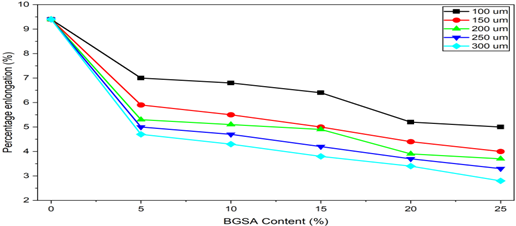Effects of Natural Fibre as Biomass Additive on the Structural and Mechanical Properties of High-Density Polyethylene Bio-Composite
Keywords:
Recycled HDPE, Bambara groundnut shell ash, Bio-composites, Tensile strength, Hardness, Wear resistance, SEM/EDSAbstract
The increasing global concern over plastic waste and environmental pollution has prompted growing interest in recycling and reinforcing polymeric materials with eco-friendly fillers. High-density polyethylene (HDPE), one of the most widely used thermoplastics, possesses excellent chemical resistance and processability but suffers from limited mechanical strength and wear resistance when recycled. To address these limitations, the use of agricultural by-products as sustainable bio-fillers offers an attractive alternative that simultaneously enhances material performance and promotes waste valorization. This study effects the mechanical and structural properties of recycled high-density polyethylene (HDPE) reinforced with Bambara groundnut shell ash (BGSA) as a sustainable bio-filler. Composites were developed with varying BGSA contents (0–25 wt%) and particle sizes (100–250μm) to evaluate their effects on ductility, strength, hardness, impact resistance, and wear behavior. The results show that elongation percentage decreased with increasing BGSA loading, dropping from 8.5% in neat HDPE to 4.5% at 25 wt%. Medium particle sizes, particularly 200μm, consistently maintained better ductility compared to smaller particles. Ultimate tensile strength (UTS) improved with BGSA addition, peaking at 28 MPa (12% above neat HDPE) at 15 wt% and 200μm, before declining at higher loadings. Hardness increased steadily with both higher BGSA content and smaller particle size, reaching a 51% improvement (68 BHN) at 25 wt%. Impact strength showed a decreasing trend with reinforcement, reducing from 18 kJ/m² to 12 kJ/m², though 200μm particles exhibited relatively better resistance. Wear resistance improved significantly, with wear rate reduced by 62% at optimal conditions (15–20 wt% and 200μm particle size), demonstrating potential for automotive applications such as brake pads. Scanning electron microscopy revealed improved particle dispersion with smaller BGSA sizes, while elemental analysis confirmed the presence of carbon, oxygen, silicon, and aluminum, supporting enhanced hardness at higher reinforcement levels. Overall, the results highlight that BGSA, particularly at 15 wt% and 200μm particle size, can effectively enhance the performance of recycled HDPE composites, offering an eco-friendly alternative to conventional fillers in engineering applications.

Published
How to Cite
Issue
Section
How to Cite
Similar Articles
- Christopher Mmaduabuchi Odoh, Moses Ejike Onudibia, Chukwuebuka Ifeanyi, Yangde Andekwe Ezekiel, Olisa Leonard Osimiri, Rimamsiwe Alfred, Investigation of X-Ray Shielding Properties of Concretes Made with Cassava Flour, Sawdust and Charcoal , Nigerian Journal of Applied Physics: Vol. 1 No. 1 (2025): Nigerian Journal of Applied Physics - Vol. 1 No. 1
- Chukwunwike Ossai, Samuel Emuvokeraye Omoyibo, Adrain Ohwofosirai, GSM Signal Strength Measurement in Kwale Delta State Nigeria , Nigerian Journal of Applied Physics: Vol. 1 No. 1 (2025): Nigerian Journal of Applied Physics - Vol. 1 No. 1
- Mayowa Gbalaja, Yusuf Samson Dauda, Habibat Abdulmaleek Omayoza, Samson Abu Ovansa, Lilian Omeje, Paul Adeoluwa Abolaji, Moses Amos, Analysis of Electromagnetic Radiation of Radio Waves Propagation in Okene, Kogi State, Nigeria , Nigerian Journal of Applied Physics: Vol. 1 No. 1 (2025): Nigerian Journal of Applied Physics - Vol. 1 No. 1
- Abdul Dahiru Buba, Clifford Chinedu Odiohamma, Medina Umar, Ramalan Abubakar, Sustainable Synthesis and Characterization of Graphene Nanosheets from Coconut Husk: A Green Approach for Advanced Materials , Nigerian Journal of Applied Physics: Vol. 1 No. 1 (2025): Nigerian Journal of Applied Physics - Vol. 1 No. 1
- Kasim Ibrahim Mohammed, Kasim Uthman Isah, Uno Essang Uno, Abdullahi Mann, Mohammed Ahmed, Najeebullah Yahuza, Nafarizal Nayan, Optimisation of Polyacrylic Acid Usage as Surfactant in Hydrothermally Synthesised Cu2ZnSnS4 Thin Films for Application as Counter Electrode in Dye Sensitised Solar Cell , Nigerian Journal of Applied Physics: Vol. 1 No. 1 (2025): Nigerian Journal of Applied Physics - Vol. 1 No. 1
- Gideon Oluyinka Layade, Charles Olubunmi Ogunkoya, Hazeez Owolabi Edunjobi, Alex Israel Philip, Depth to Basement Mapping using Source Parameter Imaging (SPI): A Case Study from Federal University of Agriculture Abeokuta , Nigerian Journal of Applied Physics: Vol. 1 No. 1 (2025): Nigerian Journal of Applied Physics - Vol. 1 No. 1
- Suleiman Abubakar Fada, Ahmed Rufai Usman, Bashir Gide Muhammad, Aliyu Mustapha Ibrahim, Abdullahi Maaruf, Gidado Shehu, Nasiba Ishak, Aliyu Lawal Albaba, Emanuel Joseph, Radiation Therapy for Cancer Treatment in Nigeria: Inception, Slow Progress and Challenges , Nigerian Journal of Applied Physics: Vol. 1 No. 1 (2025): Nigerian Journal of Applied Physics - Vol. 1 No. 1
- Semiu Salau, Saheed K. Ishola, Rafiu B. Adegbola, Adeyemi V. Kuyinu, Geoelectrical Resistivity Approach to Groundwater Potential Mapping: A Case Study of Ginti Community, Ikorodu, Lagos , Nigerian Journal of Applied Physics: Vol. 1 No. 1 (2025): Nigerian Journal of Applied Physics - Vol. 1 No. 1
You may also start an advanced similarity search for this article.




